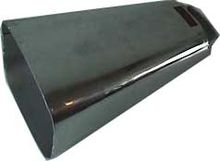Cowbell (percussion instrument)
Cowbell , also herd bell (English cowbell , Spanish cencerro , French sonnaille ), is a surcharge idiophone in the form of a handy trapezoidal, rectangular or beehive-shaped cowbell without a clapper made of iron, copper or brass sheet 10 to 20 or more centimeters in length.
The percussion instrument is held in the palm of the hand and struck with a thick wooden stick and dampened by hand if necessary. It is used to beat the basic beat in Cha-Cha-Cha , for example , and is also used again and again in Salsa . It is often played by the bongocero (the bongo drummer). The full tones are created by striking the lower end of the bell (at the opening) with the wooden stick, accents and overtones are created by striking the upper part of the bell. Alternatively, the instrument can also be attached to the drums or timbales .
The instrument probably goes back to similar instruments in West Africa. There are known single or paired metal bells without clapper. Double bells are in turn differentiated into those that are attached to a stem and others that are connected by a bracket. One of the stem double bells is the Gankogui of the Ewe in Ghana , the Ngonge (also Ngunga, Engongui ) in Nigeria , which was the model for the Brazilian Agogô , has a handle .
Tuned alpine bells with clappers are used in alpine folk music .
